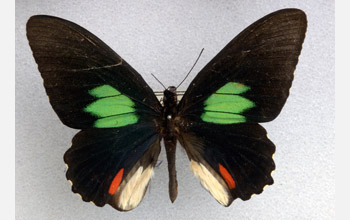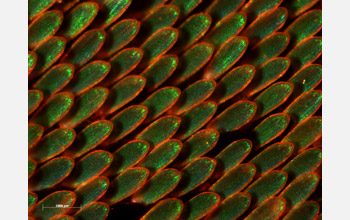 |
| The Amazonian butterfly emerald-patched cattleheart. |
 |
| Like shingles on a roof, vivid, emerald-green scales adorn the wings of the Amazonian butterfly, emerald-patched cattleheart. More about this Image Researchers from Yale University, supported by the National Science Foundation, are studying the properties of the colors of butterfly wings. Using an X-ray scattering technique, they were able to determine the 3-D internal structure of the scales on the wings of several species of butterflies. The crystal nanostructures that give butterflies their color are called gyroids--strange, 3-D curving structures that selectively scatter light. The gyroids are made of chitin (the same tough, starchy material that forms the exoskeletons of insects and crustaceans), which is usually deposited on the outer membranes of cells. Researchers wanted to know how the cells sculpt themselves into these extraordinary forms resembling a network of three-bladed boomerangs. They discovered that the outer membranes of the butterfly wing scale cells grow and fold into the interior of the cells. The membranes then form a double gyroid--two, mirro-image networks shaped by the outer and inner cell membranes. The latter are easier to grow but are not as good at scattering light. The chitin is then deposited in the outer gyroid to create a single, solid crystal. After this, the cell dies, leaving behind the crystal nanostructures on the butterfly wing. Photonic engineers are using gyroid shapes to try and create more efficient solar cells and, by mimicking nature, may be able to produce more efficient optical devices as well. |

No comments:
Post a Comment